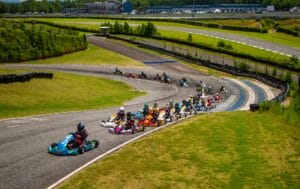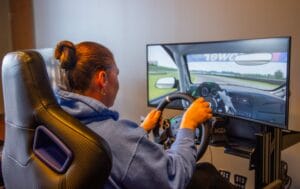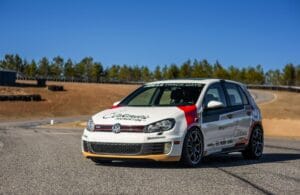Some motorsport fans may not take karting seriously, but catch racing pros from F1 and other series like NASCAR on the weekend, and they are most likely behind the wheel of a kart.
Why? Well, for one, going back to karts marks a return to form for most of these guys. As Road & Track puts it: “Every Formula 1 driver had to start somewhere, and racing karts at a very young age is how most champions are cultivated.”
But even then, something about kart racing charms the most grizzled pro racecar drivers. It is, in many ways, one of the purest forms of racing. Everything is distilled into its most essential parts, putting you as close to the engine and the asphalt as is humanly possible. In other words, once you “get” kart racing, you can “get” racing other vehicles in an intensely meaningful way. Apex turning, brake thresholds, spotting passing opportunities — skills like these can be honed from behind the wheel of a simple platform that gets rid of everything you don’t need and replaces it with pure bliss.
That is why so many parents wake up at 4 in the morning, helping their 12 year old load up a kart in the back of a pickup and starting the procession towards a long day of karting. They know their child is developing skills that could lead them down a long road towards professional skill-building. And who knows? Maybe some day, that former child looks up from their car, sees thousands of racing fans screaming down at them and quietly thanks their mom or dad for waking up early and helping them race.
How Kart Racers Compete
Kart racing can start as young as five years old. At this age, children are riding what are unsurprisingly known as “Kid Karts.” These babies usually pack a 50cc, two-stroke engine that’s not too different from what you’d find on a weed wacker. Comer c50 and c51 engines are popular, but you may also see Honda GX35 or GXH50 four-cycle engines. At this age, no one keeps track of points, and there’s no championships, but parents and kids still clamor to do their best on the weekends and keep track of their own progress.
Once kids hit about seven years old, they can compete in the SKUSA “Cadet” class. Here, they ride 60cc two-stroke engines capable of reaching 50 mph. 7-9 year olds ride in the Micro Swift group while 9-13 year olds ride Mini Swift setups.
12 year olds can then move up to the Junior class, where the competition gets truly fierce. Full-size 125cc TaG (touch-and-go) karts are common, as are Rotax setups. Many racers also run four-cycle LO206 or Jr. II Briggs engines to keep on a tight budget. Speeds can reach 65 mph, but the sheer torque makes you feel like you have been rocket-launched after exiting every corner. Kids can learn lots of skills in these classes, and not all of them related to just driving. Preparation, vehicle maintenance, strategy and more can all be developed at a young age from behind the wheel of a kart.
Moving Beyond Kart Racing in Atlanta
Once children reach age 15, they can switch to the Senior classes of karting, which include two-stroke TaG and Rotax as well as four-cycle classes like LO206 or World Formula. Exhausts are unrestricted at this point, letting karts reach 70 mph or more depending on the track. Older teens can also move to shifter karts, which can reach over 100 mph and use a manual gearbox that demands rapid, precise shifts.
However, many teens migrate to actual vehicles once they hit about 15 years old. Spec Miata is a popular class for beginning drivers and club drivers of all ages, and racers can move up to the MX-5 Cup once they find sponsorships or have more room to invest in their team. “Late Model” racing is also popular, and it helps teens gain footing in NASCAR-type stock auto racing.
But for teens who truly want to get into open-wheeled Formula 1 style racing, Formula Ford is the way to go. These vehicles are relatively affordable, and provide a good working environment for young drivers to cut their teeth and learn to work with a team. From there, they may be able to get a sponsorship and race in the GP3 series if they are willing to move to Europe, but most of us in the States have to once again entrust in Mazda. The Mazda Road to Indy has been established as a driver development program that helps provide scholarships to aspiring Indy drivers and open-wheeled racers, and there are many other, similar driver development programs out there intended to cultivate and highlight young talent.
Get Your Start by Trying Kart Racing Near Atlanta at AMP
The road to becoming a professional F1 or Indy driver is long and full of potholes, but every child and teen can get a fun start competing in kart racing. Even if they never make it to the sponsored leagues, they can build skills that can help them later in life both on and off the track.
If you are interested in learning more about kart racing at Atlanta Motorsports Park, you can attend our Atlanta kart racing school or come to the track for public karting and then talk to our kart services experts — who can even build you a complete Kid Kart, TaG kart or LO206 that’s ready to race! Book your session today!




